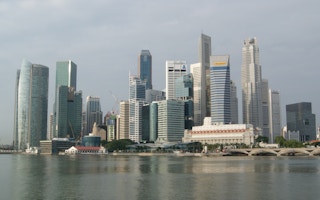Singapore’s building regulator is seeking more funds to support landlords who upgrade systems used to power and cool structures, which account for a third of the nation’s electricity consumption.
The Building and Construction Authority wants more money after exhausting S$100 million ($78 million) allotted in 2009 to help property owners make their developments more environmentally friendly, Chief Executive Officer John Keung said. It needs the funds to offer incentives and programs to help owners of older properties upgrade, he said.
“New buildings aren’t a problem, our bigger challenge is existing buildings because retrofitting can disrupt existing operations,” he said in an interview in Singapore. “So we are helping fund part of the retrofitting to get them to go green.”
Singapore is aiming to have 80 percent of its properties meet its green standards by 2030 as buildings make up a fifth of its land area, a city-state that’s smaller than the size of New York City. The authority said a recent study of 36 commercial properties that upgraded cooling systems showed energy consumption fell 16 percent.
The government agency is using the funds to match expenses by landlords for upgrading their facilities to meet green standards, capping the grant at S$3 million, Keung said. The authority will also help fund an energy audit to track the efficiency of the air-conditioning plants. Only 21 percent of the city’s buildings meet its green standards now, it said.
Green standard
Singapore’s property owners made 1,650 buildings environmentally friendly since 2005 when the authority introduced the green standard, Keung said. The additional cost for a new property to meet its certification would raise expenses by as much as 5 percent, which could be recovered through energy savings in 2 1/2 years to 6 1/2 years, he said.
The city’s floor area per capita for green buildings, or the amount of space in those properties compared with the number of occupants, was 8.7 square meters (93.6 square feet) last year, according to data from the authority. In California’s four biggest cities including Los Angeles andSan Francisco, the ratio was 3.8 square meters, according to data from U.S. Green BuildingCouncil.
California was ranked first in the U.S. with 6,438 commercial buildings meeting the widely used Leadership Energy and Environmental Design, or LEED standards.
Energy emphasis
The Singapore regulator studied the major green rating systems in the U.K., Australia and the U.S. and adapted to suit local conditions, it said. Unlike LEED, the Singapore certification places more emphasis on energy efficiency, the authority said.
To push developers to add more environmentally-friendly aspects to properties, the government stipulated in land sales that developers bidding for sites in the business districts will have to meet its highest green standards, Keung said.
The effort by the authority comes as office rents are just starting to recover after a slump of more than a year. The Singapore office rental index rose 0.2 percent in the second quarter from the three months ended March, the first increase in 1 1/2 years, according to government data.
The payback period for office buildings to meet the standards varies from four to eight years, with no financial returns for adding green features in residential developments, according to Tan Swee Yiow, president of Singapore operations at Keppel Land Ltd., the property developer partly owned by the world’s largest builder of oil rigs.
“As environmental issues dominate global agendas, businesses today recognize that going green is no longer an option, but a necessity,” Tan said in an e-mailed response.
Tenant attraction
Keppel Land (KPLD) and its partners have invested almost S$90 million on residential and commercial projects in Singapore and overseas to make them environmentally friendly, Tan said.
CapitaLand Ltd. (CAPL), Southeast Asia’s biggest developer, aims to exceed the regulator’s requirements, Francis Wong Hooe Wai, chairman at the company’s green committee, said in an e-mailed response to queries. Twenty three of its 29 shopping malls and office buildings have achieved at least the minimum green standards set by the regulator, he said.
“Green buildings are naturally more attractive to tenants,” Wong said.
Six Battery Road, which is owned by its property trust CapitaCommercial Trust (CCT), was renovated for S$92 million, of which about 3.7 percent was set aside to achieve the green rating, he said. The return on the building in the city’s financial district is estimated at 4.7 years, he said.
The government will allow developers to build more space to incentivize them to construct green properties, Keung said. It also plans to train 20,000 people to design, build and maintain these projects by 2030, from 6,000 currently, he said.
“Last year, a new legislation was passed that requires all existing buildings will need to meet the minimum green standards whenever they upgrade their cooling systems,” Keung said. “So it’s a matter of time that all buildings will have to become green as they start upgrading their systems.”










